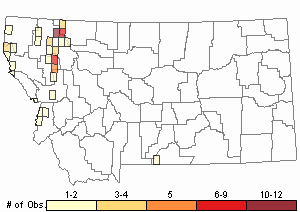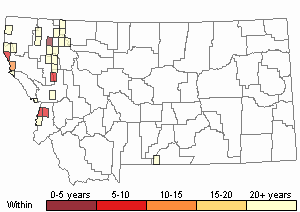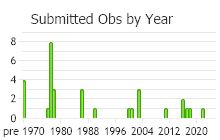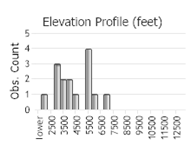View in other NatureServe Network Field Guides
NatureServe
Montana
Utah
Wyoming
Idaho
Wisconsin
British Columbia
South Carolina
Yukon
California
New York
A Dry Rock Moss - Grimmia ramondii
Other Names:
A Black Rock Moss,
Dryptodon patens
General Description
Plants: Coarse, deep green to nearly black, or yellowish to brown, frequently growing in thick mats, or more crowded with ascending stems. Stems procumbent to nearly erect (Crum et al. 1981), frequently with curved branches (Smith 1980).
Leaves: Erect or lightly appressed and sometimes somewhat curved at the ends when dry, erect-spreading (Crum et al. 1981) and frequently subsecund when wet (Smith 1980), 2.5-3 mm in length, lanceolate and slightly oblong, gradually narrowing to the apex; apex dull to sharp, narrow (Crum et al. 1981), smooth or a bit toothed (Smith 1980); margins smooth, curved under in the bottom half on one or both sides, 2-cell layers thick (Crum et al. 1981); nerve strong, ending at the apex or nearly so, conspicuously 2- or 4-winged on the back side (Crum et al. 1981).
Leaf Cells: Basal cells narrowly oblong or linear, sinuose; basal marginal cells in several rows, nearly square to short-rectangular; upper cells smooth, nearly square to rounded, frequently elongated crosswise (Crum et al. 1981).
Phenology
Capsules ripen in spring (Smith 1980).
Range Comments
In North America: Aleutian Islands, extending across se AK to AB, s to MT and OR, also in MI and Newfoundland. Also Japan, throughout the mountainous areas of Europe, Iceland, Greenland, and the Faeroe Islands (Crum et al. 1981).
Observations in Montana Natural Heritage Program Database
Number of Observations: 69
(Click on the following maps and charts to see full sized version)
Map Help and Descriptions
Relative Density

Recency



 (Observations spanning multiple months or years are excluded from time charts)
(Observations spanning multiple months or years are excluded from time charts)
Habitat
Dry to wet rocks (mostly granitic) in the mountains (Crum et al. 1981) from mid to high altitudes (Smith 1980).
Reproductive Characteristics
Dioicous, seldom fruiting. Setae yellow (Smith 1980), smooth, 2-4 mm in length, upright and somewhat flexuose when dry, curved when wet, mostly single, seldom paired. Capsules cylindric and oblongish, brown, 1-1.7 mm in length, furrowed/striate when dry; peristome teeth upright, brown, sometimes with reddish tones, split over halfway down into 2 filiform segments, thickly papillose (Crum et al. 1981).
Stewardship Responsibility
References
- Literature Cited AboveLegend:
 View Online Publication
View Online Publication Crum, H.A. and L.E. Anderson. 1981. Mosses of Eastern North America. 2 volumes. Columbia University Press, New York. 1328 pp.
Crum, H.A. and L.E. Anderson. 1981. Mosses of Eastern North America. 2 volumes. Columbia University Press, New York. 1328 pp. Elliott, J.C. and A.K. Pipp. 2018. A Checklist of Montana Mosses (1880-2018). Updated 3 January, 2020. Montana Natural Heritage Program, Helena, Montana. 73 pp.
Elliott, J.C. and A.K. Pipp. 2018. A Checklist of Montana Mosses (1880-2018). Updated 3 January, 2020. Montana Natural Heritage Program, Helena, Montana. 73 pp. Smith, A.J.E. 1980. The Moss Flora of Britain and Ireland. Cambridge University Press, Cambridge. 705 pp.
Smith, A.J.E. 1980. The Moss Flora of Britain and Ireland. Cambridge University Press, Cambridge. 705 pp.
- Additional ReferencesLegend:
 View Online Publication
View Online Publication
Do you know of a citation we're missing? Elliot, J. C. 1993. Second checklist of Montana mosses. Unpublished report. U.S. Forest Service, Region 1. Missoula, MT. 45 pp.
Elliot, J. C. 1993. Second checklist of Montana mosses. Unpublished report. U.S. Forest Service, Region 1. Missoula, MT. 45 pp. Lawton, E. 1971. Keys for the Identification of the Mosses on the Pacific Northwest. Reprinted from 'Moss Flora of the Pacific Northwest'. Published as Supplement No. 2 of the Journal of the Hattori Botanical Laboratory. Nichinan, Miyazaki, Japan. 66 pp.
Lawton, E. 1971. Keys for the Identification of the Mosses on the Pacific Northwest. Reprinted from 'Moss Flora of the Pacific Northwest'. Published as Supplement No. 2 of the Journal of the Hattori Botanical Laboratory. Nichinan, Miyazaki, Japan. 66 pp. Lawton, E. 1971. Moss Flora of the Pacific Northwest. Hattori Botanical Laboratory. Japan: Yamabuki-cho, Shinjuku-ku, Tokyo. 362 pages plus appendices.
Lawton, E. 1971. Moss Flora of the Pacific Northwest. Hattori Botanical Laboratory. Japan: Yamabuki-cho, Shinjuku-ku, Tokyo. 362 pages plus appendices.
- Web Search Engines for Articles on "A Dry Rock Moss"





